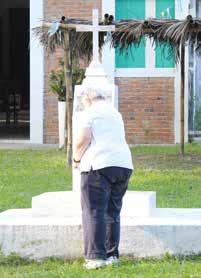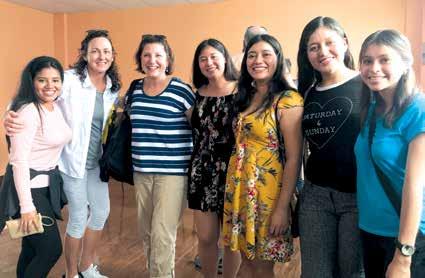
7 minute read
Reflections on the People and Beauty
Reflections on the people and beauty of EL SALVADOR By Wendy Hoke
My knowledge of Central America in general and El Salvador in particular was filtered through my experience of growing up in the Jimmy Carter and Ronald Reagan years. The policies and events that led to the death of four American churchwomen were a mystery to me. But I remember vividly how shocked I was by the news of their deaths. It seemed impossible to my 13-year-old brain that anyone would have been threatened by the work of these holy women. It wasn’t until I picked up Ursuline Sister Cynthia Glavec’s biography, “In the Fullness of Life,” over Thanksgiving two years ago that I learned about Sister Dorothy Kazel’s calling to serve the people of El Salvador. Her example moved me deeply and with her connection to Beaumont, was one that I felt must be taught and shared. Over the past school year, students, faculty and staff dove deeply into the life and legacy of Sister Dorothy, reading her biography, learning firsthand from those who knew her best, reflecting on who she was as a person. It was also time to restart our mission trip to El Salvador and get to know the people who were so important to Sister Dorothy. Last November, Sister Cheryl Mentkowski, OSU, Director of Mission Integration, and I made our first trip to El Salvador with a group from the Church of St. Dominic, which has a robust mission in the mountain town of Chiltiupan. This was the parish’s “relational” trip, perfect for our Ursuline experience. We left Cleveland on a chilly November morning and arrived in San Salvador to a blast of heat, humidity and sun. “Bienvenidos,” greeted us from a giant billboard along with tropical greenery and the hundreds of Salvadorans that lined the sidewalk scanning the new arrivals for their loved ones. Within minutes of stepping outside, we were greeted by our guides and interpreters – Aine, Jesus, Herbert and Aristides – whom we would come to know and love in short order. With windows open in our bus we pulled onto the streets, past steers and horses, banana palms and sugar cane fields.
I had spent the weeks leading up to the trip filling my notebook with what I didn’t know about El Salvador – its history, people, culture, religion, economy. The journalist in me wanted to record everything. But I was overwhelmed and instead closed my eyes, felt
Sister Cheryl Mentkowski and Wendy Hoke
the wind and took in the sounds and smells. Our first stop was the Chapel of the American Churchwomen in Santiago Nonualco, some distance from the airport and our hotel. As we approached the chapel, I found myself wondering what it must have looked like to those four women on December 2, 1980. Did they know what was about to happen?
The chapel is just off the now-paved road, next to a large meadow and under the shadow of an enormous tree. I found it equal parts haunting and peaceful. What has this tree witnessed? Sister Cheryl is overcome with emotion as she touches the marker describing how the women “gave over their lives” nearly 40 years ago. I held her as she wept.
During the first of our daily masses, with roosters crowing outside, we are asked to keep our eyes and hearts open. Mira. (Look)
This was a trip to build relationships. We would spend the vast majority of our time on top of the mountain in the canton of Chiltiupan. On the long drive up the mountain, we bond with our fellow travelers and especially our guides. They sing and play guitar and make an amazing effort to get to know everyone beyond just a surface level. The conversations are deep, faith-filled, personal, funny, tragic and hopeful.
In Chiltiupan, we pile into the back of pickup trucks. For more than an hour we make our way through dirt trails, some of which were being cleared following the end of the rainy
Natalia and her younger sister Maria Jose.

Sister Cheryl takes a moment to pray for Sister Dorothy Kazel.


President Hoke and Patty Hollis ’82 meet with college students from Chiltiupan.
season. The sky was a deep blue, what Aristides called a “fresh” day.
On our way to Cuervo Abajo School we pass bamboo stands and cypress, and the brilliant red of coffee beans and massive poinsettia trees. All the while, we are learning about El Salvador – its crops, healing plants, its people. When we arrive at this remote school, we are greeted by a marching band and students anxious to welcome us. We learn how far these young people travel just to go to school. Later we meet a college student from this remote school, hearing firsthand how dedicated he was to getting his education.
My many years of Spanish return in strange bursts. “ Como se dice, can I take your photograph?” With my Nikon, I am enchanted by the faces, the children. Their smiles are infectious. In her book, “What You Have Heard is True,” writer Carolyn Forche describes the Salvadoran people as lit from within. And that is indeed true.
But life is hard. Poverty in Chiltiupan is unlike anything I’ve seen in the States. In the cantons, we come upon homes made of mud floors and walls (if they have them), open fires for cooking and lamina for roofing. No running water or electricity. Pigs, chickens, parakeets and goats wander in and out of houses. The stories we hear are powerful. Despite the conditions, families work hard to create a better life for their children.
I was struck by simple things that moved me as a parent. Children’s backpacks hanging outside a door to a two-room home with mud floors and walls. Or the use of paper towel and toilet paper tubes that nailed high on a wooden beam safely hold toothbrushes and toothpaste.
We met many families, but one that stands out for me was the family of Maria Jose. She is a young girl with muscular dystrophy. Her mom works as a live-in housekeeper in San Salvador. Maria is cared for by her abuela (grandmother) and her 13-year-old sister, Natalia.
Maria Jose is a joy-filled girl who runs and dances and cries when she’s happy. She loves to give hugs (abrazos) and kisses (bezos). But I was taken with Natalia. She was quick to show her report card; she was clearly very bright and so proud of her grades.
Later I asked if she would be able to continue with school. As long as her abuela could manage, Natalia could stay in school. My fear is she will likely not finish high school. I want our students to meet Maria Jose and Natalia.
As I write these reflections, I see so many faces: the mischievous boys hiding up in a tree and the girls who give hugs so freely, especially when there’s candy in your pocket. And the women, who will clear a bench and invite you to sit in their home, with such grace, honored by our presence, when in fact they honor us by inviting strangers into their homes. And Raul who’s deep faith and beautiful prayers sustained us all.
My first trip to El Salvador feels big and momentous. It stimulates the senses: the smell of wood cooking fires and burning trash; the enchanting sight of being led through a mountain pass by a kaleidoscope of Monarch and Blue Morpho butterflies; the taste of grilled corn tortillas filled with beans and cheese; the majesty of the ceiba, cypress and bamboo trees; the warm hugs ( abrazos) of our new friends; and the soul-stirring sounds of the Spanish music.
But it is also incomplete. I have questions. I want to know more and I can’t wait to go back with our students, to see the people and the country through their eyes. Our June trip was cancelled due to COVID-19, but we look forward to returning next summer.

